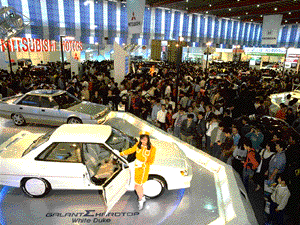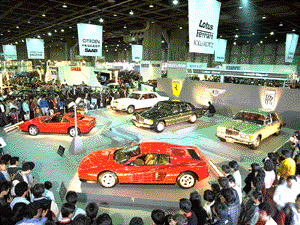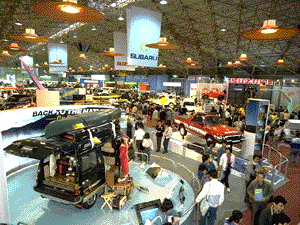 |
 |
 |
The
26th Tokyo Motor Show (1985
. 10/31 - 11/11)
 |
 |
| The 26th Tokyo Motor Show Poster |
"The Culture of Motoring: The New Generation of Vehicles"
The year 1985 was the 100th anniversary of the production
of the first practical vehicle equipped with a gasoline
engine. "Driving Culture; New Vehicle Generation" was
adopted as the most suitable theme for an international
motor show in this significant year to learn from the
history and look to the future.
In over 100 years of automobile history, vehicles born
as transport machines have spawned vehicle culture and
civilization closely linked with climate, culture, and
people s lives in various places in the world.
In Europe, that culture produced automobiles used for
leisurely drives or sports by aristocrats and wealthy
farmers. This is true to this day. Drive trains, suspensions,
tires and sporty features are especially developed in
European cars.
|
 |
 |
 |
On the other hand, the U.S. established a mass production
system and a popular automobile culture. The famous Ford
Model T excelled in terms of low price and overcoming
bad roads. As a result, automobiles spread all over the
nation, in both cities and rural areas, creating the original
form of today s American life.
In contrast to Western countries, Japan has developed
a social situation that may be described as a "medium
automobile culture." Japanese automobiles, equipped even
better than high-class cars of other countries although
small and low-priced, are creating a third vehicle culture
different from that of Europe or the U.S..
The spread of Japanese-type automobiles cannot be separated
from the following characteristics of Japanese society:
the feeling of the majority that they belong to the middle
class, family orientation, nuclear families, shopping
centers in the suburbs, a flourishing restaurant industry,
and growing orientation toward leisure.
The U.S. had lagged behind in small car production but
began to recover its original development and production
capabilities. Europe was regaining its vigor by announcing
a number of distinctive cars. Japan also continued to
strive to create "mechatronics cars" for a new age, making
full use of electronics.
The world saw a new century of automobiles through the
efforts of automakers in various countries. The important
thing was to look at cultural aspects of vehicles beyond
mere transportation, and to develop richer "culture."
For the motor show in the year 1985, with only 15 years
left before the 21st century, "Driving Culture, New Vehicle
Generation" was considered the most appropriate theme.
A press day was provided for the first time prior to the
general opening, which made reporting easier and more
active. The show attracted about 4,500 journalists (including
600 foreign correspondents). The events most popular among
foreign journalists were 20 minute briefings on the exhibits
at each stand by presidents or executives in charge of
technology.
The competitive spirit that led domestic auto makers to
make all-out efforts to expand domestic automotive demand
in response to trade friction and appreciation of the
yen also made their enthusiasm about the motor show so
great that it flourished both in size and content. Exhibits
numbered 1,032, an all time high, including 229 exhibits
from 40 non-Japanese companies. The show featured international
characteristics.
In line with the theme of the show, there were a large
number of concept cars regarded as new generation cars.
Eight of the nine domestic automobile manufacturers exhibited
a total of 23 vehicles of this type.
To summarize the technological trends, this show featured
a twin cam 4-valve engine and four-wheel drive/four-wheel
steering system. In addition, it was a show for mid engines.
These technologies were put to practical use very fast.
The twin cam 4-valves which appeared in the previous show
was exhibited by eight passenger car makers. The 4WDs
also were sold by 8 automakers. Furthermore, full time
4WD system was adopted by Mazda, by Fuji Heavy Industries
and then by Mitsubishi. Surprisingly, this system was
also adopted by Toyota and Nissan. The 4WS that Mazda
pioneered, which attracted much attention at the previous
show, was also adopted by Toyota and Nissan at this show.
Also in the truck section, Nissan Diesel displayed for
reference a four wheel steering system which got attention.
Midship-type engines were seen in the Nissan MID 4, the
Daihatsu Charade De Tomaso 926R, the Isuzu COA-II, the
Suzuki R/S1 and others. Technological advancement progressed
so fast that twin turbos were considered outdated, giving
way to a combination of superchargers and turbos, and
intercoolers using coolant appeared.
Concept cars diverged into two new streams: the futuristic
and the realistic. Many of the former sought to become
cars for a new age - mechatronics cars. All were equipment
with information systems. They were proposed as the ideal
cars for the 1990s, combining high performance and comfort.
On the other hand, realistic cars could go on sale as
soon as the next day. Many of this type had midship engines,
and were convertible to make driving more for fun. The
following are examples: Suzuki R/SI, Isuzu COA-II, Daihatsu
Mira Cabriolet, the LUC-2, Nissan s light sports car,
the FOUR based on Toyota Celica GT, Isuzu Piazza Convertible,
Mazda Familia Cabriolet, and theBe-1 that was popular
as part of the nostalgia boom.
Exhibitors commented that both the futuristic and realistic
cars could be mass produced and sold within five years
at the latest, indicating that the exhibitions had grown
to a high-standard show which presented realistic expectations
as well as futuristic dreams.
The fact
that the popularity of high-tech cars in the Passenger Car Hall
produced a chain reaction in the Parts Hall was another change
noticed at this motor show. Crowds came to this hall, which
normally was visited by few people. Every corner was full of
visitors. The reason seemed to lie in the visitors intention
to feel the content of high-tech cars, which they could not
touch in the passenger hall.
The Commercial Car Hall, which had seemed like a business show,
did not present a rigid image. It brimmed with a variety of
vehicles full of new ideas. What attracted attention was a competitive
lineup of popular delivery vehicles, and also a display of effective
transport in which information processing systems played a main
role.
With Japanese government support for promoting vehicle imports
to avoid trade friction, the foreign vehicle hall was more crowded
than ever. The hall had a luxurious feel with a spacious display
area. It was jammed with cars for reference display let alone
new models. Some conspicuous exhibits were: the Porsche 959,
BMW M3, Benz 190E 2.3-16, a concept car Citroen Eole, and Saab
900Turbo 16 EV-1 equipped with 60 solar cells for starting the
motor. The lineup of European superstar cars was really spectacular.
Besides the exhibitions, visits by many executives and technicians
from major American and German automakers and their eager viewing
of the show was impressive. GM displayed a Cadillac with the
steering wheel on the right for the Japanese market, which kicked
off its full-scale export strategy for Japan.
|
 |
|
|
|